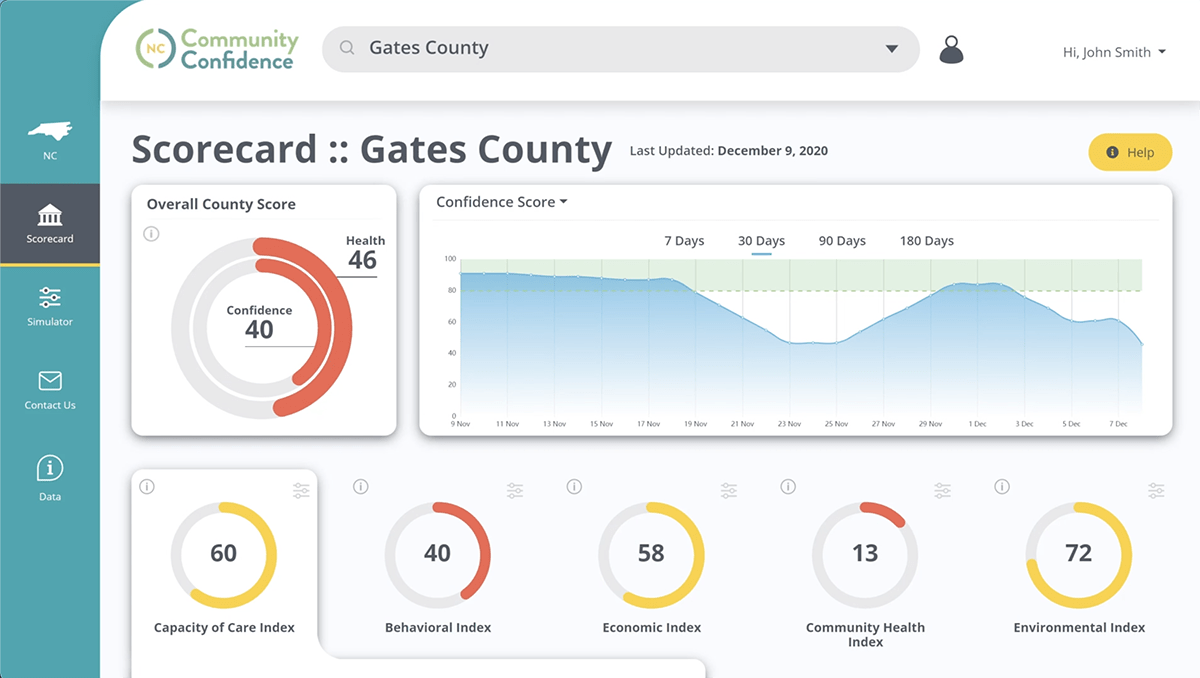
We’re going a step further by measuring the tension between economic recovery and disease transmission. Everyone else is only measuring economic recovery. There’s a difference between how much people are buying online and how much they’re out in public, potentially putting themselves or others at risk.

Tommy Bohrmann
Chief Scientific Officer
The Problem: How to Balance Reopening the Economy While Managing Virus Transmission
Communities across the country have suffered in immeasurable ways throughout the COVID-19 pandemic. North Carolina’s businesses are no exception to the rule, especially as many business owners have had no choice but to dip into personal savings to stay afloat.
Now that the U.S. vaccine campaign is gaining some serious momentum, businesses and consumers are getting antsy for things to get “back to normal.” But how can they do that safely while there’s still a serious pandemic unfolding? That’s precisely what the Digital Health Institute for Transformation set out to understand.
The Problem-Solver: Digital Health Institute for Transformation (DHIT)
The North Carolina-based non-profit organization lives and breathes its mission every day: To maximize health in underserved communities across the nation and beyond by providing equal access to global advancements in care. In other words, they are laser-focused on leveraging technology and other forward-looking innovations to help local communities eliminate health inequality and inequity once and for all.
The Challenge: Community Confidence Project
In 2020, DHIT launched the Community Confidence Project. The project, in a nutshell, was created specifically to help North Carolina communities finally begin returning to business-as-usual with a higher degree of safety and confidence.
DHIT wanted to understand how communities could strike the right balance between moving forward with reopening plans while also avoiding detrimental spikes in COVID-19 cases, which, if left unchecked, could hinder those reopening efforts in a significant way.
To bring these kinds of insights to life, DHIT had to gain a deeper understanding of how people felt about the economy reopening as well as how confident they were that their local leaders and businesses could do so safely. They were also curious to see what, if any, differences existed between people’s perceptions and their actual behaviors, as this could help explain why certain communities may have experienced spikes in virus transmission while others didn’t.
The goal was to equip local leaders, especially those in rural communities, with the right information, so they could make smarter, more informed decisions about how to reopen their local economies safely. It was also an opportunity to underscore the implications of failing to do so. After all, reopening too fast—and letting people move freely between communities—could set all of those well-intentioned efforts many steps backward.
The Solution: SafeGraph Core Places and Patterns Data
After surveying a number of different data providers, DHIT ultimately chose to work with SafeGraph because of how clean and accurate its mobility dataset was. In fact, Tommy Bohrmann, DHIT’s Chief Scientific Officer explained, “I was very happy with how the dataset was organized, it really only took me a few steps to connect it with other datasets.”
Because DHIT needed to leverage various data sources to conduct this analysis and build these insights, it was absolutely critical that any other third-party data it brought into the fold would work seamlessly together. In this case, to understand actual consumer behaviors, DHIT needed SafeGraph’s data to help tell a story that other data sources alone couldn’t tell.
“Ultimately, SafeGraph was the only data source that made it possible for us to monitor trends at both the county and sector levels,” said Bohrmann. “It offered us the perfect amount of granularity to understand how people were actually moving about and coming into contact with each other at a hyper-local level.”
The Result: Creating Visualizations That Tell the Full Story
By monitoring changes in economic activity in relation to ongoing pandemic dynamics, DHIT was able to create eye-opening visualizations around how different communities were faring at different stages of reopening and what key drivers were leading to those results. They provided an information snapshot to help answer a few pressing questions:
- What do people think their community’s behaviors should be?
- How are people actually behaving and moving about in the real world?
- What are the real pandemic dynamics happening at the local level?
“SafeGraph data helped us paint a more holistic picture around what’s going on with our economy, our people, and the disease,” shared Bohrmann. “And it’s helped local leaders understand the impact of their words on people’s actions, giving them an opportunity to step back and potentially re-think some of their messaging and reopening policy decisions.”

Some of the data even pointed to a delta between people’s perceptions and their actions. For example, many North Carolinians said that restaurants should be at 50% capacity and people should avoid going to public spaces, like places of worship, as much as possible. However, SafeGraph’s mobility data made it clear that people’s actions weren’t 100% aligned with their words—even at times when case counts were starting to skyrocket.
The big win here is that it has helped local leaders see the true value of data as a catalyst for helping them solve big health-related problems within their communities. It’s also given them something new to lean into for decision-making around where to invest critical resources.
The Future: Continuing to Close the Gap of Health Inequity
This journey for DHIT is far from over. The Community Confidence Project is just one piece of this puzzle, and there is much to learn as we prepare for future pandemics and population health crises. Indeed, one of the findings of the team was the clear correlation between a healthy community and positive economic impact. As Bohrmann so aptly put it, “The economic elements and health elements related to the overall health of our communities during the COVID-19 pandemic and beyond are inextricably tied. We learn a lot more by understanding where and how people move and less about what tax revenues they’re generating.” So for now, they’re keeping their eye on the prize by continuing to help North Carolina’s communities reopen safely and stem the pandemic’s negative impacts.

